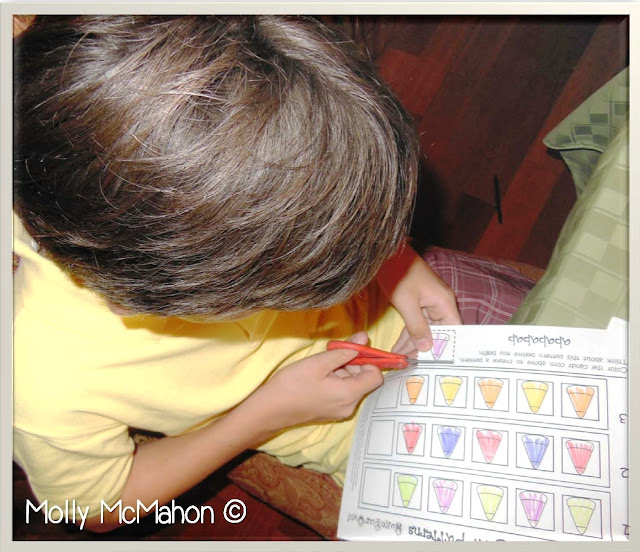"It's October and first year teacher Miss Larson prepares a math lesson on extending a repeating pattern. The evening before the lessons, she carefully counts out 8 purple and blue cubes and she puts them in a sandwich bag. She repeats this procedure 19 more times. All 20 of her kindergartners will have their own bag of manipulatives to work with at their tables. Miss Larson is confident that her upcoming lesson will be a success. During the entire month of September she has used the a-b-a-b-a-b pattern on the September calendar by alternating apples with leaves. She had pointed out the red and white stripes on the American flag and discussed the repeating pattern. The week before her lesson she had a "Show and Tell" day in which the children came to school in striped clothing to demonstrate alternating color patterns. She was sure that EVERYONE would easily master a-b-a-b-a-b patterning during her lesson. Much to her surprise, a little guy in her class named Jerry randomly places the purple and blue cubes (in no particular order) in a neat row. No repeating pattern! Miss Larson is stumped. Jerry was the calendar helper during the last week of September and demonstrated the a-b-a-b-a-b pattern sequence with the apples and leaves without hesitation. Miss Larson does not realize that Jerry has color vision deficiency. (aka: "colorblindness") If only she had known. She would have used a different medium (something other than color) to teach and assess Jerry's understanding of the concept of repeating patterns."
 |
| Using color as the medium to teach patterning concepts may not be the best choice. |
 |
| This is an "a-b-a-b-a-b" pattern. The pattern is expressed with position of the milk caps . . . "cap up-cap down-cap up-cap down . . . " |
The children's patterning days aren't over when they enter first grade either. In addition to using what they learned about patterning in kindergarten, they also need to TRANSFER a pattern from one form to another.
 |
| They need to transfer a pattern from one form to another. Get this freebie sheet by clicking here! |
 |
| This is a simple, growing pattern. |
 |
| The pattern shown above is a-b-a-b-a-b. It could be stated as: "one-two-one-three-one-four-one-five". |
I'm excited to tell you about a little resource I've created to help your students with patterning. The packet is solely for the a-b-a-b-a-b pattern. Perfect for kindergartners in the month of October! My little fellow is testing out the product. He already has mastered simple, repeating patterns but was willing to try out my activities.
First he has to continue the pattern by drawing more candy corn and pumpkins.
In row two, he'll need to draw the candy corn upside down.
The medium in row three is about size. So he'll make big and little candy corn.
Since "thinking about thinking" (or meta-cognition) is so important in order to make a concept stick, it's necessary that THEY create their OWN patterns. In the first worksheet, the pattern was already made up for him. All he needed to do was extend it! Now he has to CREATE the a-b-a-b-a-b pattern. The medium is color. He has to "program" the candy corn that gets cut out as well, using the appropriate colors. (The color medium is fine for him because he does not have "colorblindness". It's always a good thing to know your students!)
I think at this point, he had a plan to take a short cut. It was faster for him to keep the same color in his hand and skip the uncolored images.
Then he went back and colored the rest of the candy corn in the row.
He chose, what looked like, two shades of orange for the final row. Go figure!
I really liked that HE got to choose the colors for his candy corn math instead of being told what colors to use. This makes the activity a little more open-ended instead of having a "cookie-cutter" look displayed for student work.
I used square shapes for the cut-outs which is much easier to cut than any other shape. There's no point in frustrating kindergartners with their "cut and paste" activities. He was so focused on the cutting that he didn't even pay attention to the paper falling off the dining room table!
Then we glued the "programmed" pieces.
The finished work!
The packet also has a few photos that are sized for pocket charts. They're photos of candy corn and the pumpkin variety of candy corn.
Click on the image below to view the product at my shop.
Lessons by Molly © 2014 All rights reserved.















